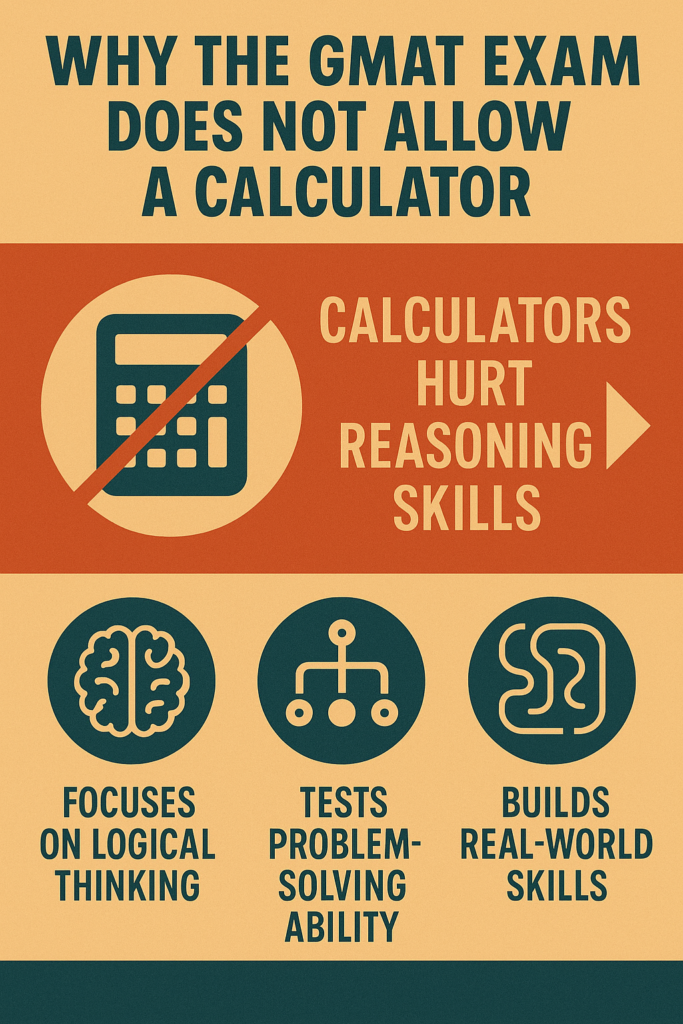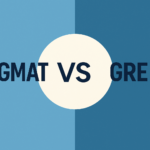Why the GMAT Does Not Allow a Calculator: Understanding the Reasoning Behind the Rules
How calculator-free testing strengthens your logic, critical thinking, and real-world problem-solving skills

When preparing for the GMAT, one of the most jarring realizations for test-takers is this: you’re not allowed to use a calculator on the Quantitative section.
That’s right. No digital crutch. No square root button. No margin for error. Just you, a dry-erase pad, and your brain.
To some, this might feel unfair or even outdated — especially in a world where calculators (or apps like Wolfram Alpha) are always within reach. But there’s a deliberate and well-reasoned purpose behind this rule. The GMAT isn’t just testing your ability to compute; it’s testing how you think.
Let’s explore why the GMAT does not allow a calculator on its Quant section, with a special emphasis on how calculator use can actually undermine reasoning skills — and why going calculator-free might be exactly what your business school (and future career) demands.
1. The GMAT Is a Reasoning Test, Not a Math Test
Let’s clear this up right away: the GMAT is not trying to assess your ability to do long division or memorize trigonometric formulas. Instead, it’s evaluating something far more valuable — your ability to:
- Analyze a problem
- Interpret numerical data
- Make logical decisions
- Identify the most efficient path to a solution
That’s why the Quant section is called the Quantitative Reasoning section. The goal isn’t pure calculation. It’s decision-making under pressure.
For example, consider this problem:
If x is an integer and 3x + 7 is divisible by 2, which of the following must be true?
To solve it, you don’t need a calculator — you need to understand number properties. The GMAT wants to see if you can reason through patterns, not just crunch numbers.
2. Calculators Are Almost Always a Cognitive Crutch
Allowing calculators changes the nature of a test. Instead of focusing on problem-solving, students are tempted to:
- Plug in all the answer choices and reverse-engineer
- Use trial and error over insight
- Rely on computation instead of conceptual clarity
This may seem efficient, but it short-circuits real reasoning. When you’re given a calculator, your brain says: “I don’t need to fully understand this — I can just try stuff.”
But the GMAT wants to know: Can you think like a manager, consultant, or analyst — even when you don’t have tools to help you?
That’s the difference between solving by logic and solving by brute force.
In fact, studies in cognitive science show that overreliance on calculators weakens mental arithmetic, estimation, and pattern recognition, all of which are essential to effective problem-solving. By removing the calculator, the GMAT forces you to think smarter — not harder.
3. Mental Math Builds Strategic Thinking
You might not believe it now, but mastering mental math under pressure makes you a more agile thinker. When you learn to:
- Estimate quickly
- Spot divisible numbers
- Recognize common squares and roots
- Simplify equations before calculating
…you’re training your brain to see the structure of a problem before diving into the weeds.
This is especially important in business environments, where leaders often need to make snap decisions based on incomplete data. If it takes you 30 seconds to mentally calculate a percentage increase, you’re already ahead of someone reaching for Excel.
Mental math also improves:
- Confidence under time constraints
- Pattern recognition (crucial for Data Sufficiency)
- Efficiency, as you avoid unnecessary calculations
The GMAT isn’t punishing you by banning calculators — it’s pushing you toward higher-level strategic reasoning. And remember, a question that is designed to be done without a calculator means you don’t need a calculator to solve the question.
4. Real-World Relevance: Calculators Aren’t Always Available
In real business scenarios — think interviews, client meetings, or executive discussions — you rarely have time (or permission) to whip out a calculator. You’ll often be expected to:
- Estimate ROI in your head
- Justify financial forecasts on the fly
- Analyze market data from a presentation in real time
Top MBA programs know this. They’re not looking for human calculators. They want thinkers who can:
- Reason through ambiguity
- Simplify complex situations
- Prioritize the most relevant information
The GMAT simulates this by giving you limited tools. In doing so, it highlights your ability to make fast, logical decisions — not just plug numbers into a device.
5. Data Sufficiency
OK–strictly speaking, DS is not part of the Quant section.
But all the same rules apply here: Data Sufficiency problems don’t ask you to solve for a number — they ask if you could solve it, based on the information provided.
For example:
Is x > 0?
(1) x² > 4
(2) x > -2
You don’t calculate anything here. Instead, you analyze logic:
- What does each statement imply?
- Are the conditions sufficient, together or alone?
- Can you draw a definitive conclusion?
A calculator wouldn’t help you even if it were allowed. That’s because Data Sufficiency isn’t about calculation — it’s about structured thinking.
These problems develop skills highly valued in:
- Management consulting
- Corporate strategy
- Business analytics
They demand efficiency, logic, and a tolerance for ambiguity — exactly the kind of reasoning calculators can’t provide.
6. The Calculator Is Allowed Where It Matters: Integrated Reasoning
Here’s something many test-takers miss: you ARE allowed to use a calculator on one part of the GMAT — the Integrated Reasoning section.
Why? Because this section involves:
- Large data sets
- Graph analysis
- Complex multi-step computations
Here, the calculator is a supporting tool, because the focus shifts to data interpretation and synthesis, not numerical reasoning. This shows that the GMAT isn’t arbitrarily banning technology — it’s making purposeful decisions about skill assessment.
In short: calculators are provided when the problem requires raw number-crunching, and withheld when reasoning is the skill being tested.
7. MBA Programs Want Strategic Thinkers, Not Mathletes
GMAT scores are used by top business schools to assess an applicant’s readiness for a rigorous, fast-paced, analytical curriculum. But they’re not looking for “math people” — they’re looking for:
- Problem solvers
- Data interpreters
- Strategic decision-makers
An applicant who can use mental estimation and logical shortcuts is often more MBA-ready than someone who relies on brute-force calculation.
Think about it: when pitching a strategy to a CEO, would you rather say:
- “Give me a sec to calculate that.”
OR - “Off the top of my head, we’re looking at a 12% increase over last quarter.”
The GMAT wants to know if you can do the latter.
8. You Can Learn to Excel Without a Calculator — And Gain an Edge
The good news? Calculator-free reasoning is a skill you can train. And mastering it gives you a huge competitive advantage.
Here’s how to build your GMAT logic muscle:
- Practice number sense (divisibility, odds/evens, prime factors)
- Memorize key values (square roots, percent conversions, common fractions)
- Use estimation instead of exact math when possible
- Simplify problems before doing any arithmetic
Over time, your brain begins to:
- Recognize traps faster
- See multiple paths to a solution
- Eliminate answer choices without full calculations
This not only boosts your score — it prepares you for the kind of intuitive, fast-paced reasoning MBA programs and employers value most.
9. Strategic Implications: Why GMAT Questions Are Designed Without Calculators
GMAC (the maker of the GMAT exam) doesn’t just want to see if you get the right answer — they want to see how you think through ambiguity, constraints, and time pressure.
By removing calculators, they:
- Level the playing field for all test-takers
- Encourage smarter approaches (backsolving, estimation, logic)
- Make each question an opportunity to showcase thoughtfulness, not just speed
This creates a more accurate predictor of business success than a test that rewards button-pushing.
Think of GMAT Quant as a mental obstacle course — not a math test.
10. The GMAT Reflects Business Reality (More Than You Think)
Ultimately, the GMAT’s calculator ban reflects real-world problem-solving in high-stakes business environments.
In consulting, private equity, startups, and even in B-school case studies, you’ll be constantly asked to:
- Make time-sensitive decisions
- Prioritize data
- Work within constraints
- Explain your reasoning — clearly, concisely, and confidently
You’ll rarely have the luxury of a calculator — and even when you do, your judgment matters more than your math.
By stripping away tools like calculators, the GMAT strips away shortcuts — and reveals your raw strategic intelligence.
The GMAT’s Calculator Ban Isn’t a Hurdle — It’s a Test of Readiness
At first glance, the GMAT’s refusal to allow calculators on the Quantitative Reasoning section may seem like a frustrating inconvenience. But in reality, it’s a feature, not a flaw — a carefully designed filter that identifies test-takers who can think, adapt, simplify, and solve.
Again, the fact that you don’t have a calculator isn’t designed to hamstring you; it means you need to learn to think around the math.
When you prepare for a calculator-free GMAT, you’re not just preparing for a test. You’re preparing for:
- Boardroom presentations
- Investor meetings
- Data-driven decision-making
- MBA-level coursework
- Leadership under pressure
You’re learning to trust your mind, structure your thoughts, and make logic your greatest tool.






